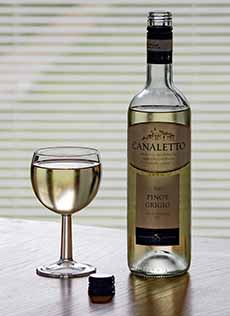Pinot Grigio: America’s 2nd Most Popular White Wine, For National Pinot Grigio Day
|
We celebrate National Pinot Grigio Day on May 17th. The refreshing white wine is perfect for warm days enjoyment, but Americans enjoy it year-round. In fact, while Pinot Grigio is the most popular white wine in Italy, it’s also the most-imported white wine in the U.S. Below: The difference between Pinot Grigio and Pinot Gris. Below: Pairing food with Pinot Grigio. While best known as an Italian grape, the varietal first appeared in the Burgundy region of France in the Middle Ages, where it was known as Pinot Gris. It was planted in Switzerland by the 14th century. The wine is said to have been a favorite of Emperor Charles IV, ruler of the Holy Roman Empire from 1355 to 1378 [source]. It was planted extensively by the Cistercian monks in Hungary and in Italy by 1375, where the now-named Pinot Grigio was destined to become the number-one Italian white [source]. In Italy, Pinot Grigio is grown largely in the cooler northeastern parts of the country: primarily the Veneto, but also Alto Adige, Friuli, Lombardy, and Trentino. Today, Pinot Gris is also grown in Australia, Austria, Chile, Germany, South Africa, and the U.S. (especially California, Oregon, and Long Island, New York) [source]. The first American Pinot Gris was planted in Oregon by David Lett of Eyrie Vineyards in 1965. The varietal was slow to catch on, though. In the 1960s, Italy’s Santa Margherita Winery began to export its Pinot Grigio to the U.S., and it ultimately became one of Italy’s largest wine exports to the States [source]. By the 1990s, American brands of Pinot Grigio began to trend higher and higher. As of 2019, Pinot Grigio/Pinot Gris was the second-largest-selling white wine in the U.S., after Chardonnay. Sauvignon Blanc was third, followed by White Zinfandel and Riesling [source]. While their popularity has led to a lot of inexpensive, mass-produced wines that are two-dimensional, there are some fine Pinot Grigios. Ask your wine store for a recommendation. There are good options from $15 upwards. While the DNA of the grapes is virtually identical, Pinot Grigio and Pinot Gris are stylistically different wines. This is because of: Pinot Grigio wines are light in body, mild in flavor, crisp, and can be dry, slightly sweet, or off-dry. They have subtle floral or delicately fruity notes. Some will be minerally. They have low acid levels as well. They’re clean, easy-drinking, refreshing wines, great for pool or patio, or for pairing with lighter foods (see below). The aromas are subtle because the grapes don’t have a high level of ripeness. But let the wine open up in the glass and look for the delicate scents of: And don’t worry if you don’t know the difference between a regular peach and a white peach, or what acacia leaf smells like (here’s the scoop). These are part of the baby steps in mastering wine. Choose warm-weather foods, nothing heavy. |
|
|
|
________________ *These two styles create sweeter wines. Vendange tardive (VT) means late harvest in French and refers to a style of dessert wine where the grapes are allowed to hang on the vine until they start to dehydrate. This concentrates the sugars in the juice. Sélection de grains noble (SGN) are even sweeter wines. The name means “selection of noble berries” which refers to wines made from grapes affected by noble rot—a very welcome rot for grapes. Here’s more about it. †Terroir, pronounced tur-WAH, is a French agricultural term referring to the unique set of environmental factors in a specific habitat that affects a crop’s qualities. It includes climate, elevation, proximity to a body of water, slant of the land, soil type, and amount of sun. These environmental characteristics give a fruit or vegetable its unique character. CHECK OUT WHAT’S HAPPENING ON OUR HOME PAGE, THENIBBLE.COM. |
||








